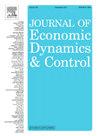货币流动性时机的最优n状态内生马尔可夫切换模型
IF 2.3
3区 经济学
Q2 ECONOMICS
引用次数: 0
摘要
在本文中,我们考察了全球多元化基金是否会根据系统性的货币流动性变动积极调整其货币敞口,我们将这种行为称为货币流动性时机。提出了一种嵌入n状态内生马尔可夫切换机制的货币-流动性-择时模型,以捕捉基金择时行为的动态,以及影响这种动态的外部和内部驱动因素。利用2001年7月至2020年12月的382只国际固定收益共同基金的样本,我们发现了样本基金在总水平上存在货币流动性时机的证据。有趣的是,基金的货币流动性择时行为在不同的市场时期表现出一种状态切换模式:基金在平静的市场时期平均从事反向货币流动性择时,但在更动荡的市场时期,积极的货币流动性择时具有更强的侵略性。我们的研究结果表明,基金货币流动性择时行为的状态转变是由外部货币市场流动性状况恶化和对内部基金收益的负面冲击驱动的。本文章由计算机程序翻译,如有差异,请以英文原文为准。
Optimal N-state endogenous Markov-switching model for currency liquidity timing
In this paper, we examine whether globally-diversified funds' actively adjust their currency exposure in response to systematic currency liquidity movements, a behavior we term currency liquidity timing. A novel currency-liquidity-timing model embedded with an N-state endogenous Markov-switching mechanism is proposed to capture the dynamics in funds' timing behavior, as well as the external and internal drivers influencing such dynamics. Using a sample of 382 international fixed income mutual funds from July 2001 to December 2020, we find evidence of currency liquidity timing at the aggregate level for the sample funds. Interestingly, funds' currency-liquidity-timing behavior exhibits a state-switching pattern across different market periods: funds on average engage in perverse currency liquidity timing during tranquil market periods, but in positive currency liquidity timing with a stronger degree of aggressivity during more turbulent market periods. Our results suggest that the state transitions in funds' currency-liquidity-timing behavior are driven by deteriorating external currency market liquidity conditions and negative shocks to internal fund returns.
求助全文
通过发布文献求助,成功后即可免费获取论文全文。
去求助
来源期刊

Journal of Economic Dynamics & Control
ECONOMICS-
CiteScore
3.10
自引率
10.50%
发文量
199
期刊介绍:
The journal provides an outlet for publication of research concerning all theoretical and empirical aspects of economic dynamics and control as well as the development and use of computational methods in economics and finance. Contributions regarding computational methods may include, but are not restricted to, artificial intelligence, databases, decision support systems, genetic algorithms, modelling languages, neural networks, numerical algorithms for optimization, control and equilibria, parallel computing and qualitative reasoning.
 求助内容:
求助内容: 应助结果提醒方式:
应助结果提醒方式:


